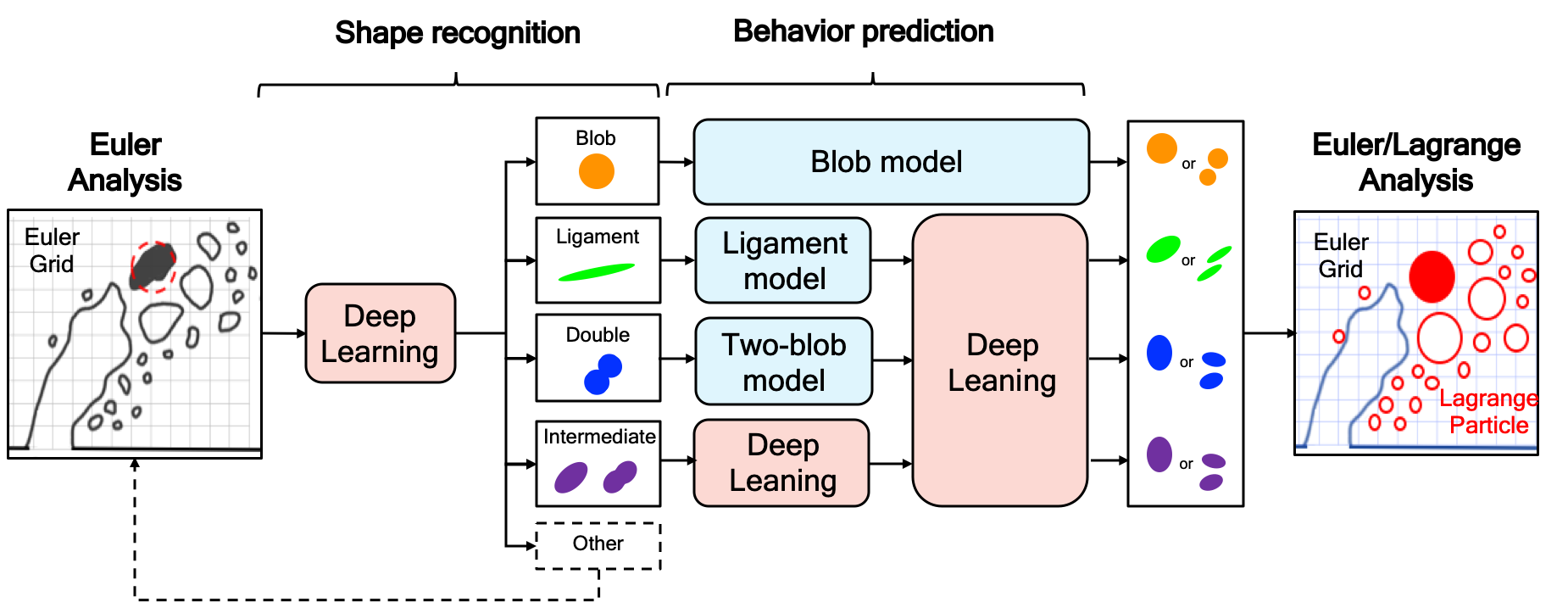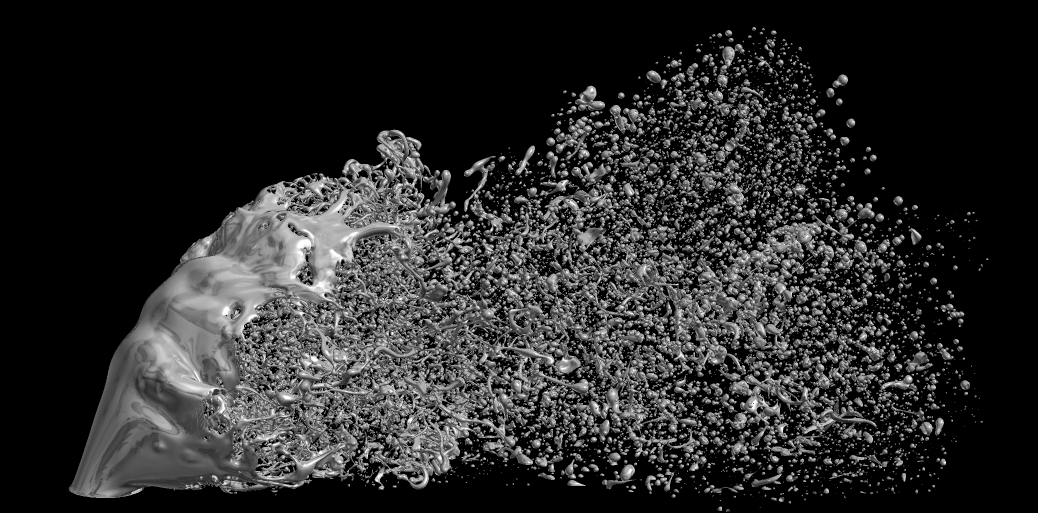The modeling of Crossflow Type Atomization
JAXA Supercomputer System Annual Report February 2021-January 2022
Report Number: R21ETET51
Subject Category: Skills Acquisition System
- Responsible Representative: AOYAMA Takashi, Director, Aviation Technology Directrate, Aircraft Lifecycle Innovation Hub
- Contact Information: Yukari Sakano(y.sakano@akane.waseda.jp)
- Members: Yukari Sakano
Abstract
This research aims to construct the numerical calculation model for analyzing crossflow atomization, which is often used in main burners of aerospace engines, with high accuracy and low calculation costs. Although only spherical droplets are replaced to Lagrange particles to decrease calculation costs in general atomization analysis, which calculates the behaviors of air flow and liquid flow other than the droplets, the new model in this research can consider droplet's shape and predict subsequent behavior of it. In detail, as shown in Fig. 1, the sub-models of "Shape recognition" and "Behavior prediction" are newly constructed, and deep learning are introduced to the parts where consume a lot of calculation cost. In order to realize this model, two topics, (1) Proposal of methods for database preparation and (2) Training & Evaluation of deep learning, are achieved in this year.
Reference URL
N/A
Reasons and benefits of using JAXA Supercomputer System
For the construction of the new atomization model, JAXA Supercomputer System is used for attaining the database of the droplet's behavior and training the deep learning network. Since the network training requires a lot of accurate and large-scale dataset, it can be efficiently gathered by conducting calculation with the solver of two-phase flow in the JAXA Supercomputer System, and the visualized results calculated by the solver are shown in Fig. 2. Simultaneously, by using the system, it has become possible to efficiently construct the model by using the GPU in the training process of a deep learning network.
Achievements of the Year
At first, we proposed a data conversion method for extracting necessary information from VOF (Volume of Fluid) data obtained from the calculation result using two-phase flow analysis solver. In detail, the method for geometrically evaluating three-dimensional shape of droplet are developed for the sub-model of "Shape recognition" sub-model, and the method for extracting time series behavior information of each droplet are developed for the sub-model of "Behavior prediction." In addition, a deep learning network are successfully trained based on datasets created based on the developed methods, and it was shown that the network is efficient to be applied to "Shape recognition" and "Behavior prediction" process.
Publications
- Peer-reviewed papers
Sakano, Y., Nambu, T., Mizobuchi, Y., and Sato, T., "Evaluation of three-dimensional droplet shape for analysis of the crossflow-type atomization," Mechanical Engineering Journal, Vol.9, No.1, 2022.
- Oral Presentations
1) Sakano, Y., Nambu, T., Mizobuchi, Y., and Sato, T., "Time Series Information Extraction Method in Crossflow Type Atomization," The 59th Symposium (Japanese) on Combustion, 2021.
2) Sakano, Y., Nambu, T., Mizobuchi, Y., and Sato, T., "Shape Recognition of Fuel Atomization in Crossflow using Deep Learning," AIAA SciTech Forum, 2022.
Usage of JSS
Computational Information
- Process Parallelization Methods: MPI
- Thread Parallelization Methods: N/A
- Number of Processes: 1452
- Elapsed Time per Case: 24 Hour(s)
JSS3 Resources Used
Fraction of Usage in Total Resources*1(%): 0.02
Details
Please refer to System Configuration of JSS3 for the system configuration and major specifications of JSS3.
| System Name | CPU Resources Used(Core x Hours) | Fraction of Usage*2(%) |
|---|---|---|
| TOKI-SORA | 371793.87 | 0.02 |
| TOKI-ST | 22008.36 | 0.03 |
| TOKI-GP | 53.71 | 0.04 |
| TOKI-XM | 0.00 | 0.00 |
| TOKI-LM | 0.00 | 0.00 |
| TOKI-TST | 0.00 | 0.00 |
| TOKI-TGP | 0.00 | 0.00 |
| TOKI-TLM | 0.00 | 0.00 |
| File System Name | Storage Assigned(GiB) | Fraction of Usage*2(%) |
|---|---|---|
| /home | 10.00 | 0.01 |
| /data and /data2 | 6500.00 | 0.07 |
| /ssd | 100.00 | 0.03 |
| Archiver Name | Storage Used(TiB) | Fraction of Usage*2(%) |
|---|---|---|
| J-SPACE | 0.00 | 0.00 |
*1: Fraction of Usage in Total Resources: Weighted average of three resource types (Computing, File System, and Archiver).
*2: Fraction of Usage:Percentage of usage relative to each resource used in one year.
ISV Software Licenses Used
| ISV Software Licenses Used(Hours) | Fraction of Usage*2(%) | |
|---|---|---|
| ISV Software Licenses(Total) | 4.38 | 0.00 |
*2: Fraction of Usage:Percentage of usage relative to each resource used in one year.
JAXA Supercomputer System Annual Report February 2021-January 2022




